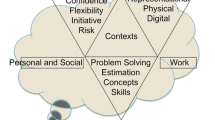Abstract
The development of numeracy, sometimes known as quantitative literacy or mathematical literacy, requires students to experience using mathematics in a range of real-world contexts and in all school subjects. This chapter reports on a research study that aimed to help teachers in ten schools plan and implement numeracy strategies across the middle school curriculum. Teachers were introduced to a rich model of numeracy that gives attention to real-life contexts; application of mathematical knowledge; use of representational, physical, and digital tools; and positive dispositions towards mathematics. These elements are grounded in a critical orientation to the use of mathematics. Over one school year, the teachers worked through two action research cycles of numeracy curriculum implementation. The professional development approach included three whole-day workshops that supported teachers’ planning and evaluation and two rounds of school visits for lesson observations, teacher and student interviews, and collection of student work samples. During workshops, teachers also completed written tasks that sought information about their confidence for numeracy teaching and how they were using the numeracy model for planning. Drawing on data collected during workshops and school visits, we demonstrate how teachers’ instructional practices changed over time as they progressively engaged with the numeracy model.
Access this chapter
Tax calculation will be finalised at checkout
Purchases are for personal use only
Similar content being viewed by others
References
Australian Association of Mathematics Teachers. (2006). Standards for excellence in teaching mathematics in Australian schools. Retrieved June 5, 2012, from http://www.aamt.edu.au/content/download/499/2265/file/standxtm.pdf
Australian Curriculum, Assessment and Reporting Authority. (2012). General capabilities in the Australian Curriculum. Retrieved March 24, 2012, from http://www.australiancurriculum.edu.au/GeneralCapabilities/Overview/
Board of Teacher Registration, Queensland. (2005). Numeracy in teacher education: The way forward in the 21st century. Brisbane: Author.
Cohen, D., & Hill, H. (2001). Learning policy: When state reform works. New Haven: Yale University Press.
Geiger, V., Goos, M., & Dole, S. (2011). Teacher professional learning in numeracy: Trajectories through a model for numeracy in the 21st century. In J. Clark, B. Kissane, J. Mousley, T. Spencer, & S. Thornton (Eds.), Mathematics: Traditions and (new) practices (Proceedings of the 23rd biennial conference of the Australian Association of Mathematics Teachers and the 34th annual conference of the Mathematics Education Research Group of Australasia, pp. 297–305). Adelaide: AAMT & MERGA.
Goos, M. (2007). Developing numeracy in the learning areas (middle years). Keynote address delivered at the South Australian Literacy and Numeracy Expo, Adelaide.
Goos, M., Geiger, V., & Dole, S. (2010). Auditing the numeracy demands of the middle years curriculum. In L. Sparrow, B. Kissane, & C. Hurst (Eds.), Shaping the future of mathematics education (Proceedings of the 33rd annual conference of the Mathematics Education Research Group of Australasia, pp. 210–217). Fremantle: MERGA.
Human Capital Working Group, Council of Australian Governments. (2008). National numeracy review report. Retrieved January 7, 2011, from http://www.coag.gov.au/reports/docs/national_numeracy_review.pdf
Jablonka, E. (2003). Mathematical literacy. In A. Bishop, M. A. Clements, C. Keitel, J. Kilpatrick, & F. Leung (Eds.), Second international handbook of mathematics education (pp. 75–102). Dordrecht: Kluwer.
Loucks-Horsley, S., Love, N., Stiles, K., Mundry, S., & Hewson, P. (2003). Designing professional development for teachers of science and mathematics (2nd ed.). Thousand Oaks: Corwin Press.
McLeod, D. (1992). Research on affect in mathematics education: A reconceptualization. In D. Grouws (Ed.), Handbook of research on mathematics teaching and learning (pp. 575–596). New York: Macmillan.
National Council of Teachers of Mathematics. (2000). Principles and standards for school mathematics. Reston: NCTM.
National Curriculum Board. (2009). Shape of the Australian curriculum: Mathematics. Retrieved June 5, 2012, from http://www.acara.edu.au/verve/_resources/Australian_Curriculum_-_Maths.pdf
Noss, R., Hoyles, C., & Pozzi, S. (2000). Working knowledge: Mathematics in use. In A. Bessot & J. Ridgeway (Eds.), Education for mathematics in the workplace (pp. 17–35). Dordrecht: Kluwer.
Organisation for Economic Cooperation and Development. (2004). Learning for tomorrow’s world: First results from PISA 2003. Paris: OECD.
Sfard, A., & McClain, K. (2002). Analyzing tools: Perspectives on the role of designed artifacts in mathematics learning. The Journal of the Learning Sciences, 11(2&3), 153–161.
Steen, L. (2001). The case for quantitative literacy. In L. Steen (Ed.), Mathematics and democracy: The case for quantitative literacy (pp. 1–22). Princeton: National Council on Education and the Disciplines.
Zevenbergen, R. (2004). Technologising numeracy: Intergenerational differences in working mathematically in new times. Educational Studies in Mathematics, 56, 97–117.
Author information
Authors and Affiliations
Corresponding author
Editor information
Editors and Affiliations
Rights and permissions
Copyright information
© 2014 Springer International Publishing Switzerland
About this chapter
Cite this chapter
Goos, M., Geiger, V., Dole, S. (2014). Transforming Professional Practice in Numeracy Teaching. In: Li, Y., Silver, E., Li, S. (eds) Transforming Mathematics Instruction. Advances in Mathematics Education. Springer, Cham. https://doi.org/10.1007/978-3-319-04993-9_6
Download citation
DOI: https://doi.org/10.1007/978-3-319-04993-9_6
Published:
Publisher Name: Springer, Cham
Print ISBN: 978-3-319-04992-2
Online ISBN: 978-3-319-04993-9
eBook Packages: Humanities, Social Sciences and LawEducation (R0)




